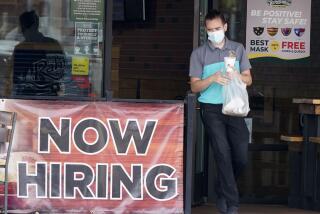Household Income Drops, U.S. Says
- Share via
WASHINGTON — The income of American households fell last year and the poverty rate increased for the first time since the early 1990s, the Census Bureau reported Tuesday, reversals that could pose problems for the Bush administration and dramatize the fallout of economic recession.
The trends on poverty and income underscored the reality that a less-forgiving economic climate has replaced the buoyant growth of the 1990s, at least for now. To many workers, the recession in 2001 meant a loss of jobs or a cut in working hours. Such changes helped drag down family income and push people into poverty in much of the United States.
“It’s a very common pattern,” said Daniel H. Weinberg, chief of housing and household economic statistics at the Census Bureau. “It’s just what we tend to see around each recession.”
The trends in income and poverty varied widely by region, racial group and even age.
The national poverty rate rose to 11.7% in 2001 from 11.3% the previous year, the first increase since 1992.
But among the racial categories, only whites registered an overall increase in the poverty rate. The South was the only region where the overall poverty rate went up.
About 32.9 million Americans were counted as poor last year, an increase of 1.3 million from 2000. Growth in poverty was concentrated in metropolitan areas and the South.
The poverty threshold for a family of four was $18,104 in 2001, up from $17,603. For a family of three, the threshold was $14,128.
As poverty increased, a key measure of income declined. Median household income fell 2.2% to $42,228, a drop of $934, meaning that half of households had incomes above $42,228 and half below.
Income levels fell for whites, blacks and Asians and stayed steady for Latinos. Regionally, income levels fell in much of the United States except in the Northeast, where they stayed flat.
Although the broad patterns fit with past recessions, some were struck by new evidence that the poor were trailing further behind the rest of society than in the past. Those classified as poor on average fell further below the poverty line than any year since 1979.
By some measures, the rich in 2001 remained just about as much richer than the poor. Yet 2001 was the first year in which the richest 20% of Americans earned more than half the nation’s total personal income. The share of income going to the poorest Americans declined.
“The poor did become poorer in 2001,” said Robert Greenstein, executive director of the Center on Budget and Policy Priorities, a liberal think thank in Washington.
Moreover, some commentators predicted harder economic times would continue to aggravate income and poverty trends. As negative portents, Greenstein cited the unemployment rate, the rising number of jobless workers who have exhausted their insurance benefits and actions by a growing number of states to cut back on social services.
“The increase in poverty is likely to be larger in 2002 than the increase of 1.3 million people that occurred in 2001,” Greenstein said.
Although economists rarely pin the responsibility for hard times on an individual president, the public tends to view matters differently, and some suggested Tuesday that the trends highlighted by the Census Bureau threatened headaches for the Bush White House.
“I’m sure the Democrats will make extensive use of these numbers,” said Robert E. Litan, vice president and director of economic studies at the nonpartisan Brookings Institution. “They’ll say that after a decade of uninterrupted progress, here we see--early into a Bush administration--a reversal of some of these gains. I think it will be a big part of the debate.”
In perspective, the numbers announced for poverty and income remained near all-time bests. For example, the household income figures, even after adjustment for inflation, were higher than all years before 1999, and the poverty rate was lower than every year of the 1980s and 1990s. (The poverty rate of 11.3%, recorded in 2000, was the lowest level since 1974.)
Bush administration officials sought to highlight the favorable trend of recent years, rather than the reversals of 2001, as arguments to pass a new version of welfare reform. The nation’s welfare program is scheduled to expire in a week, and Congress remains split over such issues as child-care spending, work rules and benefits for immigrants.
The new census data “continue to underscore the need for strengthening our efforts to help families move from welfare to work,” said Wade F. Horn, assistant secretary for the Administration of Children and Families.
Among regions, the Census Bureau reported, median household income levels dropped 3.7% in the Midwest, 2.3% in the West and 1.4% in the South. The South continued to have the lowest median income levels in the United States.
Manufacturing in the Midwest suffered a sharp blow, as did areas of California and elsewhere with major high-tech presences.
“The lingering problems of the manufacturing sector have taken a toll” in the Midwest, said Scott Hoyt, director of consumer economics at Economy.com, a consulting firm in West Chester, Pa. “The manufacturing sector went into it first, and except for a few areas like autos, hasn’t come out of it yet.”
Regarding the West Coast’s decline in household income, Hoyt continued, “There’s a reasonably high probability that all the tech problems” have influenced the census findings.
Among racial and ethnic groups, median household incomes held steady for Latinos, but fell 1.3% for non-Latino whites, 3.4% for blacks and 6.4% for Asians and Pacific Islanders.
Some analysts were surprised at the racial disparities in poverty trends highlighted by the report. The poverty rate increased for whites--to 9.9% from 9.5%--and non-Latino whites--to 7.9% from 7.4%.
The rate held statistically steady for other major groups, although in some cases at high levels. The poverty rate was 22.7% for blacks, 21.4% for Latinos and 10.2% for Asians and Pacific Islanders.
Analysts offered few instant explanations of why the burden of an increased poverty rate seemed to fall most directly on whites.
“If you’re going to have an overall trend, it’s usually driven by the largest group in the population,” said the Census Bureau’s Weinberg, inviting other explanations.
Wendell Primus, director of income security at the Center on Budget and Policy Priorities, suggested that the real test of how blacks and other racial groups fare in recession may not be over, given the economy’s continued weakness.
The child poverty rate of 16.3% was about the same as the year before, and well below the child poverty rate of 22.7% in 1993.
More to Read
Get the L.A. Times Politics newsletter
Deeply reported insights into legislation, politics and policy from Sacramento, Washington and beyond. In your inbox twice per week.
You may occasionally receive promotional content from the Los Angeles Times.










